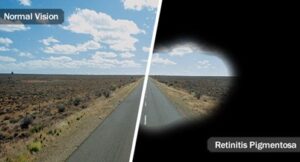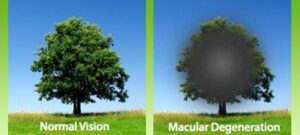Forever in darkness
By Tahmid

Blindness can be detrimental to the quality of life of people who experience it; there are many different causes, some which have a cure whilst other ones do not. The most common cause of blindness in the world is cataracts, and this does have a cure; the treatment is a simple surgery which involves removing the old lens and replacing it with a new, artificial one. Unfortunately, a lot of people in the developing world do not have access to the necessary treatments. However, in this article, I will primarily focus on the causes of blindness which do not have a cure yet.
Retinitis Pigmentosa
The first cause of blindness we will discuss is a condition called retinitis pigmentosa. Although the name does sound like a spell, I assure the condition has nothing to do with the world of Harry Potter. Retinitis pigmentosa, or RP for short, is an inherited condition; this means it is something that you can get from your parents. To make matters a bit more advanced, RP is inherited in what scientist call autosomal dominant pattern; all this simply means is that only one of the parents need to have the condition for the child to have it as well. In terms of how common it is, studies have shown that approximately 1 in 4000 people will have this condition.

Okay, now that we have the understand the basic inheritance of RP, we can now move onto the more interesting stuff about RP. So, what actually is RP? Well, in all honesty, the actual process of what happens is quite complex and even scientists do not have the details fully figured out yet. Just to give you an idea of how complex it is, scientists estimate there are more than 300 genes involved which are disrupted. A gene is simply a section of our DNA which codes a for a certain protein. Therefore, as a result of all these mutations, the photoreceptors in our retina begin to degenerate. What is a photoreceptor, I hear you ask? Well, a receptor is a type of cell which detects changes around itself, so in the case of a photoreceptor, it is a cell which detects light, i.e. the “photo” part. There are predominantly two types of photoreceptors found in the eye, cone cell and rod cells. Cone cells are for colour vision and rod cells are mainly used when there is low light, for example at night.
The symptoms someone with RP experiences can be matched to the loss of each type of photoreceptor lost. So, in the case of rod cell loss, it means there is worsening night vision as rod cells are mainly active when there is not enough light. In regard to the loss of cone cells, the resulting symptoms include decreased visual acuity, which is the fancy way of saying increased blurriness and loss of colour vision. RP can arise at any age, usually between 10 and 40 years of age, and begins as loss of peripheral vision, which describes the vision in the corners of your sight. At first, this goes unnoticed but as the disease worsens, patients become more aware of their impaired sights.
As I have mentioned before, RP has no cure yet and doctors currently prescribe treatments which slow down the process of degeneration. This includes ensuring patients are taking enough supplements which are good for the cells in the eye, for example, vitamin A, fish oil and vegetables. Interestingly, in vegetables, scientists have found a substance called lutein which has been shown to have a role in reducing the loss of peripheral vision.
Age-related macular degeneration
Another cause of blindness which does not have a cure yet is age-related macular degeneration. The macula is the centre of the retina and is key for our central vision and colour vision. In some people, as they get older, especially above 50 years of age, some cells in their macula get destroyed and the reason for this is attributed to excess inflammation. Usually, inflammation is good as it helps with tissue healing since during inflammation, there is increased blood flow, allowing the body to bring cells which remove the damaged parts and more material for repair. However, when there is too much inflammation, or unnecessary inflammation, it can lead to destruction of healthy cells without the repair function. Therefore, as the macula degenerates, patients complain that they often cannot make out the face of the people they are talking to as the centre of their vision is blurred.
There are two types of age-related macular degeneration, which are dry and wet. Dry is the milder version, and this form is much more common. In dry macular degeneration, there is the destruction of the macular described but at a much slower pace. It is usually treated with lifestyle advice such encouragement to stop smoking and ensuring a good intake of healthy foods which contain plenty of vitamins and antioxidants. Antioxidants are like super nutrients which help to limit the excessive inflammation as described before.
The other type of age-related macular degeneration is the wet type, and this is much worse. In this case, patients deteriorate much faster and can completely lose their vision if treatment is not given urgently. The wet type is differentiated from the dry type by the fact that in the wet type there is abnormal growth of new blood vessels in the back of the eye. The treatment for this is to give regular injections right into the eye (yep, you read that right) which contain drugs which prevent the growth of the abnormal blood vessels. These do work but only to slow the disease process; eventually, there will be severe loss of central vision.

Fortunately, scientists are working really hard to find cures for many of the incurable causes of blindness today.



